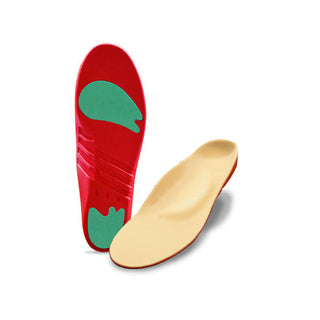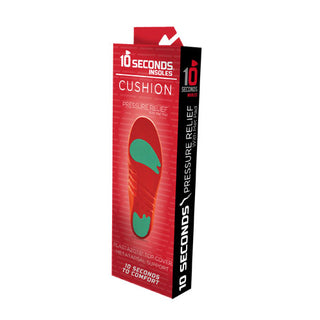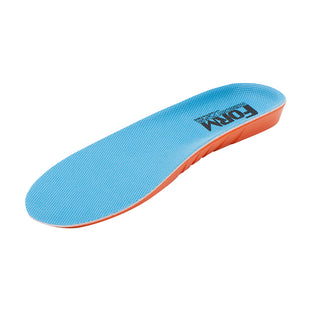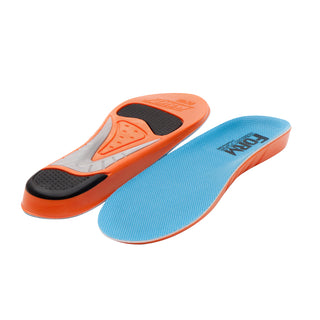Fat Pad Atrophy Symptoms and Relief
Recommended for Fat Pad Atrophy Symptoms and Relief
View allNoticing persistent foot pain and discomfort?
It could be a degenerative condition called fat pad atrophy. Fat pad atrophy is a condition where the protective fat pads on the bottom of the feet begin to deteriorate and thin out over time which can impact your mobility and quality of life.
Learn more about the signs of fat pad atrophy and how orthotics may be able to help.
Why Fat Pads in Your Feet Matter
Fat pads are made of thick connective tissue in your heel and the ball of your foot, and they help distribute pressure and provide support when walking.
The heel fat pad is specialized to cushion the heel bone, making it a key player in providing shock absorption and stability to your feet. This complex network of fat and soft tissues helps preserve foot health and provides comfort - especially when walking on hard surfaces.
What is Fat Pad Atrophy?
These fat pads, located under the heel and ball of the foot, act as natural shock absorbers to cushion the feet during walking, running, and other weight-bearing activities.
As the fat pads atrophy or wear down, the feet lose this protective cushioning, leading to pain, discomfort, and potentially other foot conditions. Fat pad atrophy is more common in older adults, as the fat pads naturally thin with age, but it can affect people of all ages, especially those with certain risk factors.
How common is heel fat pad atrophy?
Heel fat pad atrophy is quite common as it is considered the second leading cause of plantar heel pain after plantar fasciitis. Heel fat pad syndrome is often misdiagnosed as plantar fasciitis.
Causes of fat pad atrophy
Several factors can contribute to the development of fat pad atrophy, including:
- Age: As we get older, the fat pads naturally begin to thin and lose volume.
- Overuse: Repetitive high-impact activities, such as running or jumping, can accelerate fat pad deterioration.
- Obesity: Excess weight puts additional stress on the fat pads, leading to faster wear and tear.
- Certain medical conditions: Diseases like diabetes, rheumatoid arthritis, and peripheral neuropathy can affect foot health and contribute to fat pad atrophy.
Symptoms of fat pad atrophy
The primary symptoms of fat pad atrophy include:
- Heel pain or ball of foot pain, especially during weight-bearing activities
- A feeling of walking on bones or pebbles
- Calluses or skin thickening on the heel or ball of the foot
- Thinning or loss of the natural padding on the bottom of the feet
- Difficulty tolerating long periods of standing or walking
- Aching or burning sensation in the feet
It’s important to consult a medical professional for an accurate diagnosis.
Treatment for fat pad atrophy
Treatment options for fat pad atrophy aim to reduce pain, protect the remaining fat pad tissue, and improve foot function. Some common treatments include:
- Wearing supportive, well-cushioned shoes with ample arch support and a wide toe box
- Using orthotic insoles or custom-made foot pads to provide extra cushioning and support
- Modifying activities to reduce high-impact stress on the feet
- Losing weight, if necessary, to alleviate pressure on the feet
- Physical therapy to strengthen foot muscles and improve flexibility
In severe cases, fat grafting or dermal fillers may be used to restore lost fat pad volume
Do Insoles Help With Fat Pad Atrophy?
Yes, insoles can be an effective part of the treatment plan for fat pad atrophy!
Insoles provide much-needed cushion and support to shoes that can ease discomfort and pressure. Properly designed insoles can:
- Provide extra cushioning to protect the remaining fat pad tissue
- Redistribute pressure evenly across the foot to reduce stress on the heel and ball of the foot
- Support the arch and improve foot alignment, which can help alleviate pain and discomfort
- Act as a shock absorber to minimize the impact of walking and other weight-bearing activities on the feet
What to Look for in Insoles for Fat Pad Atrophy
When choosing insoles for fat pad atrophy, we recommend that you look for the following:
- Ample cushioning, especially in the heel and ball of the foot areas
- Deep heel cups to cradle and protect the heel fat pad
- Metatarsal pads to offload pressure from the ball of the foot
- Arch support to help distribute weight evenly across the foot






